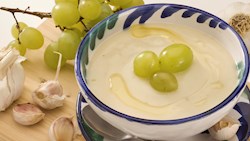MAIN INGREDIENTS
La jota triestina is a traditional soup originating from Trieste. Although there are various versions, the dish is usually made with a combination of beans, olive oil, potatoes, sauerkraut, flour, pancetta, garlic, cumin, bay leaves, salt, and pepper.
The garlic, pancetta, and potatoes are fried in olive oil and mixed with the beans. The mixture is covered with water, covered, and simmered until the beans are tender. A mixture of sauerkraut, cumin, and bay leaves is boiled until the liquid has almost evaporated.
MAIN INGREDIENTS
Even though it originated as a humble peasant dish, French onion soup is nowadays regarded as one of the most prized dishes of French cuisine. The broth is simple, made merely with caramelized onions and meat stock. However, the soup is distinguished by croûtes–pieces of crispy baked bread that are placed on top of the soup and are then generously covered with cheese.
The assembled dish is finished in the oven, allowing the cheese to melt while the top turns into a golden crust. French onion soup is a dish with a rich history and a very long tradition. The onions have been used since the Roman times, and a similar soup has been known since the Middle Ages.
MOST ICONIC Soupe à l’oignon
View moreAlthough it translates as stone soup, this hearty Portuguese dish is actually a combination of beans and sausages such as chouriço and morcela (blood sausage), as well as pork belly, pig’s ear, and potatoes, while different regional varieties may also include pasta, carrots, and cabbage.
There's a legend saying that a monk in need wanted to prepare soup by using merely stones and water. When he asked for additional ingredients to supposedly flavor the soup, the family who'd hosted him was more than willing to provide some pork cuts, beans, sausages, and vegetables, and the monk ended with a rich and nutritious dish without any stones inside.
Porra Antequerana is a Spanish soup originating from the Malaga town called Antequera. Originally, the soup was served warm, and it was made with old bread, tomatoes, olive oil, garlic, vegetables, pieces of ham, hard-boiled eggs, and other ingredients the peasants had on hand.
The ingredients were puréed into a soup using a mortar (porra) and pestle. Over time, the soup started to be served cold, usually as an appetizer or a tapa. Nowadays, there are many variations on porra Antequerana, with some recipes adding ingredients such as tuna on top of the soup.
MAIN INGREDIENTS
This thick, creamy, and rich puréed soup traditionally includes ingredients such as cream, seafood, cognac or wine, and a combination of spices. The origin of its name is still debated – some claim that the word refers to a soup that is cooked twice (bis cuits), since the traditional way of making the soup involves first roasting the shellfish and then simmering them again in the flavorful broth.
Another theory suggests it is related to the Bay of Biscay, whose cuisine typically uses spicy ingredients similar to those used in bisque. Bisque was first mentioned as a shellfish soup in the 17th century, leading food historians to suggest that it was originally a fisherman’s dish that was designed to get the most flavor out of whatever ingredients were available.
VARIATIONS OF Bisque
Pasta e ceci is a thick Italian soup featuring pasta and chickpeas as the main ingredients. Any kind of pasta can be used in the soup, from maltagliati to cannolicchi. The dish is usually prepared with a soffrito of onions and celery that is simmered in a chickpea broth, while the pasta is added later.
This classic, comforting dish is traditionally served on Friday throughout Italy.
This thick French soup is made with puréed leeks, onions, potatoes, cream, and chicken stock. There is an ongoing debate about its origin – some claim it has French roots, while others insist that the soup is an American invention.
One group of food historians say that the soup was invented by French chef Jules Gouffe in 1859, while others believe the original creator to be Louis Diat, a French chef who worked at the New York Ritz-Carlton. Inspired by the potato and leek soup of his childhood, he named the soup crème Vichyssoise glacée after his hometown of Vichy.
Today, the soup is traditionally served cold and is often garnished with fresh chopped chives.
This hearty bread soup is a Portuguese classic that combines thick, crusty slices of rustic bread and a flavorful broth that is infused with garlic, olive oil, and generous amounts of fresh cilantro or mint. Although it occasionally employs meat or sausages, in its basic form the soup is traditionally served topped with a poached egg.
Also popular is the seafood version of the dish, which typically employs cod fish and goes under the name of açorda de bacalhau à Alentejana. Like other varieties of açorda, Alentejana was invented as a frugal meal that soon developed into a true Portuguese classic.
This traditional Provençal fish soup (and stew) originated in the 18th century when it was first concocted by Marseillaise fishermen, who would prepare it using the leftovers from their daily catch, making the best of what they had in their nets.
Over time, bouillabaisse evolved into one of the most luxurious seafood dishes in the world: it is found in every upscale restaurant in the lively seaport city of Marseille where it can cost up to €200 for a meal for two. Anything below €50 is considered an ordinary fish soup—a good rule of thumb for those who want to taste the real thing.
MOST ICONIC Bouillabaisse
View moreMAIN INGREDIENTS
Salmorejo is a refreshing Andalusian soup that is traditionally served cold. It is especially popular during the warm, summer days. The soup consists of puréed tomatoes, bread, garlic, oil, and vinegar. Thick and creamy, salmorejo is often garnished with ingredients such as hard-boiled eggs or Spanish ham.
In some cases, it can be served as a tapa dish or as a sauce accompanying toasts or omelets.
MOST ICONIC Salmorejo
View moreTasteAtlas food rankings are based on the ratings of the TasteAtlas audience, with a series of mechanisms that recognize real users and that ignore bot, nationalist or local patriotic ratings, and give additional value to the ratings of users that the system recognizes as knowledgeable. For the “Top 100 Western European Soups” list until March 20, 2025, 4,450 ratings were recorded, of which 3,333 were recognized by the system as legitimate. TasteAtlas Rankings should not be seen as the final global conclusion about food. Their purpose is to promote excellent local foods, instill pride in traditional dishes, and arouse curiosity about dishes you haven’t tried.






























































































